After any operation a seam remains on the human body, which fully overgrows after a while. Sometimes this period is delayed or serious complications appear that cannot be eliminated without medical assistance. If the postoperative suture does not heal, it is better to consult a surgeon and consult a specialist to rule out negative factors.
Record content:
- 1 Types of postoperative sutures and suture materials
- 2 Stages of healing of surgical wounds, timing of healing
- 3 Factors influencing the rate of wound healing
- 4 What does a scar look like in a good, dry condition?
- 5 Possible complications in the seam area and their causes
- 6 Symptoms of poor seam condition
-
7 How to speed up healing at home?
- 7.1 Local funds
- 7.2 Folk remedies
- 8 What to do in case of reddening of the seam?
- 9 What to do when sealing a seam?
- 10 What to do with seroma?
- 11 What to do in case of seam suppuration?
- 12 What to do in case of fistula formation?
- 13 What to do in case of seam divergence?
- 14 Why does the postoperative suture itch, how to eliminate itching?
- 15 Dry scar care
- 16 Postoperative Suture Care Video
Types of postoperative sutures and suture materials
Given the suture technique, there are the following types:
| Name | Description |
| Continuous | When stitching the wound, one long piece of thread is used. |
| Nodal | In the course of medical procedures, several pieces of thread are used, which are tied at a certain distance from each other.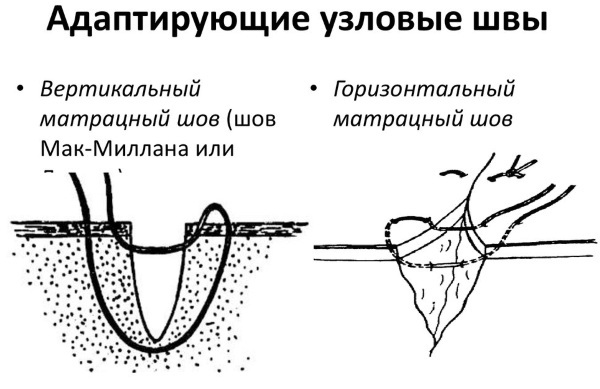
|
| Primary | Used to suture wound edges for proper tissue healing. |
| Secondary | Threads are placed on top of the primary seam to reinforce it if the edges come apart. |
| Ligature | A suture method, in case of damage to blood vessels, to restore their integrity and circulation. |
The technique of joining the edges of the wound is chosen by the surgeon, taking into account the severity of the surgery and the patient's condition.
For the manufacture of suture material, high-quality raw materials are used, which makes the threads smooth and elastic with high strength. Their advantage is good sliding and hypoallergenicity, and the threads do not swell under the influence of moisture.
There are the following types of suture materials:
- natural (silk, cotton);
- synthetic;
- absorbable (catgut, biopolymers);
- not absorbable.
Sutures for stitching a postoperative wound are made from one type of raw material or several at once, they can have a different coating. The suture material is chosen by the doctor, taking into account the type of operation and the patient's condition.
Stages of healing of surgical wounds, timing of healing
Full healing of the postoperative suture requires careful wound care, this is the only way to minimize the likelihood of serious complications. It is important during the recovery period to strictly adhere to the doctor's recommendations.
There are several stages in the healing of a postoperative suture:
| Name | Description |
| Active phase | At this stage, collagen is formed. Fibroblast promotes tissue healing, which moves to the site of injury. |
| Epithelialization | The surface of the wound is covered with epithelium. After a while, a protective layer forms, preventing the penetration of infection. |
| Closing the wound | The area of damage is reduced due to the contraction of myofibroblasts. |
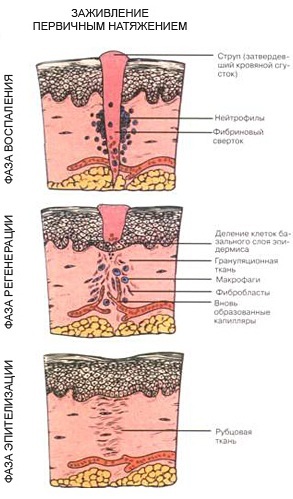
After 3 months, the epithelial tissue is completely rebuilt. A scar is formed, which is covered with an imperceptible light line. Finally, the wound heals in 1 year after surgery.
Factors influencing the rate of wound healing
The healing process of a postoperative suture depends on numerous factors:
| Name | Description |
| Age | A young body copes faster than older people. |
| Body mass | Due to poor blood supply, adipose tissue is difficult to tolerate various injuries, so stitching wounds in people with extra pounds is more difficult. |
| Food | The patient's body during the recovery period requires more vitamins and minerals for the regeneration of damaged tissues. |
| Dehydration | An insufficient level of fluid in the body affects the functioning of internal organs and systems, on which the rate of healing of the postoperative suture depends. |
| Blood supply | In an area with a large number of blood vessels, wound healing is faster. |
| Immune status | Human immunity is necessary for protection. Various disorders slow down the regeneration of damaged tissues. |
| Chronic diseases | Concomitant pathologies not only slow down the healing of the postoperative suture, but also provoke numerous complications. |
| Medications | While taking certain medications, the postoperative wound heals slowly. |
| Insufficient oxygen supply | The cells of the epidermis need a lot of oxygen for the postoperative suture to heal quickly. This process is disrupted with vascular insufficiency, tissue ischemia or against the background of hypotension. The same goes for radiation therapy, when there is an overgrowth of connective tissue and overlap of small blood vessels. |
Secondary infection significantly worsens the condition of the suture and the regeneration process when an infection enters the wound. After surgery, it is necessary to process the incision area in order to completely eliminate the negative impact of provoking factors.
What does a scar look like in a good, dry condition?
In the absence of complications, in most cases, after the operation, the patient develops a physiological scar. The seam is almost invisible and is close to skin tone in color.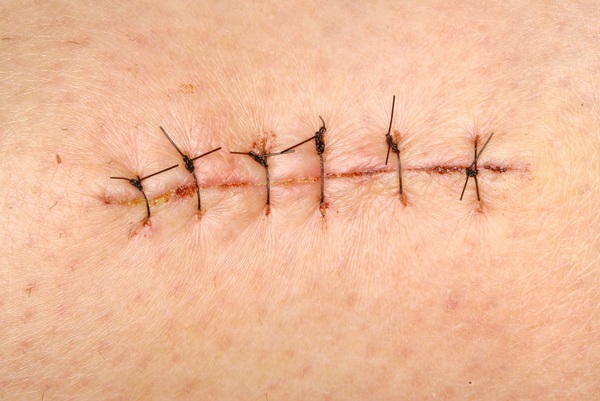
If the operation was performed on an area of the body where there is poor blood circulation, a keloid scar of white or pink hue is formed. It rises slightly above the skin and shines. Such a scar is also formed after deep surgery.
Possible complications in the seam area and their causes
The postoperative suture requires careful care and supervision by a specialist in order to heal properly.
In case of violation of medical recommendations, the patient is faced with various complications:
| Name | Description |
| Seroma | A frequent complication after surgery. Small capillaries grow together and a large amount of lymph accumulates in this area, which entails tissue edema. A serous fluid appears with a yellow tint and an unpleasant odor. |
| Suppuration | Purulent discharge from the wound occurs as a result of the ingress of pathogenic microorganisms into it. |
| Sealing | The cause of compaction is often a seroma, when a large amount of lymphoid fluid collects in the area of the surgical suture. |
| Redness | Inflammation indicates that an infection has entered the wound after surgery. |
You can not independently engage in treatment in case of complications. Consultation with a surgeon and his recommendations will help to avoid more serious consequences, including blood poisoning.
Symptoms of poor seam condition
The healing of the postoperative suture is not always perfect; in some situations, serious complications arise. An infection joins, the human body individually reacts to surgical intervention, internal seams are rejected.
An incorrectly performed operation and the development of pathological processes are accompanied by bad clinical symptoms:
- the postoperative suture becomes inflamed, nearby tissues turn red;
- the local temperature rises;

- the area around the seam swells;
- purulent or serous discharge appears from the wound;
- the edges of the seam diverge;
- the patient complains of strong painful sensations of a cramping or pulling character;
- small nodules are formed under the outer seam.
A high body temperature indicates a serious inflammatory process. The patient needs to urgently go to the hospital and receive medical attention. Severe pain syndrome may be signs of an adhesive process.
In most cases, nodules under the outer seam resolve on their own. But it is necessary to notify the attending physician or surgeon about the appearance of pathological symptoms. If necessary, a specialist will select an effective treatment.
How to speed up healing at home?
Complex therapy of the postoperative suture involves the use of antiseptic agents that reduce the inflammatory process. Wound-healing creams and gels are also used, which accelerate the regeneration of damaged tissues.
In the absence of serious contraindications, folk remedies can be used, but strictly consult with your doctor in order to exclude the appearance of complications.
Local funds
The incision does not heal often due to circulatory system problems.
In this case, it is recommended to process it with the following external agents: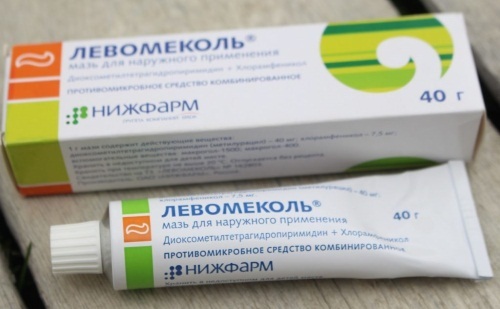
| Name | Application | Contraindications |
| Levomekol | The gel has a bactericidal and antimicrobial effect, promotes the early healing of the postoperative suture. The medicine is applied directly to the wound or the open cavity is filled with well-soaked sterile wipes. The daily dosage is 3 g. |
|
| Contractubex | The ointment is applied to the area of the postoperative suture 2 times a day in the morning and in the evening in a small amount, rubbing in with light massage movements. The standard course of treatment lasts 30 days. | Individual sensitivity |
Before applying the cream, the postoperative suture should be treated with an antiseptic (brilliant green, iodine, chlorhexidine, potassium permanganate, fucorcin). The procedures are carried out at least 2 times a day. Wash your hands thoroughly before sewing.
Folk remedies
Prescriptions of healers and healers help to quickly heal the postoperative suture, if you choose the right remedy in consultation with your doctor.

| Name | Recipe | Application |
| Tea tree oil | Add to 1 tbsp. water 3-5 drops of essential oil. Mix all components well. | It is recommended to apply the product to the seam with a gauze swab. Tea tree oil can be used neat to lubricate a postoperative wound. |
| Onion | Peel the small onion, wash and chop with a grater. | Onion gruel should be applied to the seam 1-2 times a day. The juice kills pathogenic microorganisms, promoting the regeneration of damaged tissues. |
| St. John's wort | Mix dry plant leaves (4 tablespoons) with hot water (500 ml). Insist and strain. | It is recommended to wash the wound with a ready-made solution. |
A properly selected folk remedy will help to quickly heal the seam, relieve pain and reduce inflammation. It is important to choose the method of treatment with a doctor, as an allergic reaction or worsening of the condition can be provoked.
What to do in case of reddening of the seam?
The postoperative suture does not heal often in the event of an inflammatory process. It is necessary to constantly treat the wound with antiseptics (2-4 times a day). Its redness indicates a possible infection of the wound, improperly installed drainage, or a surgical error.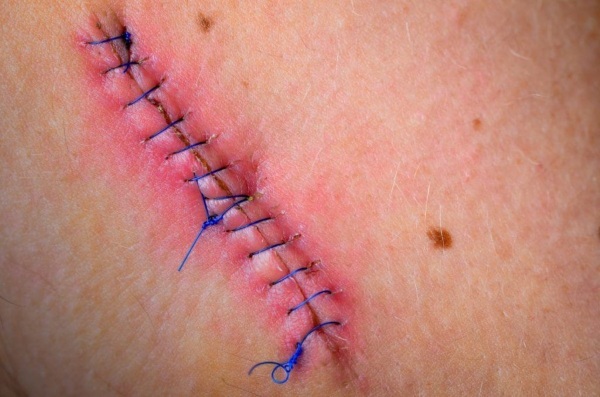
After treatment with an antiseptic, a gauze bandage with anti-inflammatory ointment should be applied to the seam, following the instructions or prescriptions of the doctor.
What to do when sealing a seam?
In most cases, the hardening of the suture occurs as a result of an accumulation of lymphoma (seroma). The cause may also be a fistula or purulent processes. To eliminate the problem, it is necessary to carefully care for the wound and visit a specialist in order to identify complications in a timely manner.
What to do with seroma?
In most cases, seroma resolves on its own in 1-3 weeks. If after the specified period it is still present, you must go to the hospital, the doctor will prescribe treatment.
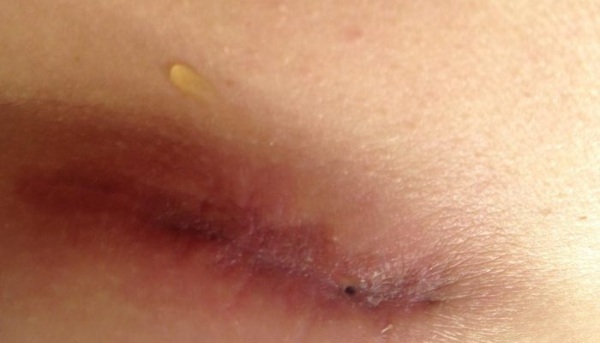
The main goal of therapy is to remove accumulated fluid. For this, drainage or vacuum aspiration is used. In each case, special devices are used to pump out the liquid.
What to do in case of seam suppuration?
Purulent processes in the seam area require immediate consultation with a surgeon. The specialist will loosen the suture and wash the wound with antiseptic agents, anti-inflammatory solution, apply a bandage with a healing cream. During the recovery period, the patient must carefully take care of the wound in order to exclude complications.
What to do in case of fistula formation?
The fistula is a kind of canal that connects the cavities. Purulent discharge comes out through it. If they are absent, an inflammatory process develops.
The cause of the fistula is an infection that has entered the wound. The same goes for a chronic inflammatory process, a foreign body. Fistulas also form if the infection has not been completely healed or the threads have been torn away.
For treatment, the patient is prescribed anti-inflammatory and antibacterial drugs. It is necessary to wash the wound with antiseptic agents, and also drink vitamins.
What to do in case of seam divergence?
Numerous reasons contribute to seam divergence:
- getting the infection into the wound;
- concomitant diseases in the human body;
- high blood pressure;
- tight sutures;
- overweight;
- bad habits;
- damage to the seam.
In this situation, the patient urgently needs a consultation with a surgeon, additional treatment and strict supervision of a specialist. In case of seam divergence, patients are also advised to wear a special postoperative bandage.
Why does the postoperative suture itch, how to eliminate itching?
The postoperative suture does not heal and itches if dirt gets into the wound. Itching is the body's reaction to the action of pathogenic microorganisms. The same happens when a wound heals, when it contracts and the skin dries up.
Itching can also appear as a reaction to the fastening threads. In this situation, it is not recommended to scratch the wound, it is necessary to continue to treat it with antiseptics, which was prescribed by the doctor and strictly adhere to the recommendations of a specialist.
Dry scar care
In some situations, the postoperative suture becomes covered with a dry crust, which absolutely cannot be removed on your own. It is also important to protect it from water, for example, in the bathroom while showering. Moisture contributes to the reproduction of pathogenic flora and the development of the inflammatory process.
The dry crust should fall off on its own, for this it is enough to use special means prescribed by the attending physician or folk recipes, if there are no medical contraindications.
In most cases, the wound heals quickly after surgery. However, sometimes certain characteristics of the patient's body slow down this process. Don't panic. If the postoperative suture does not heal, it is necessary to consult a surgeon to rule out possible complications.
Postoperative Suture Care Video
Rules and terms for handling the postoperative suture:



